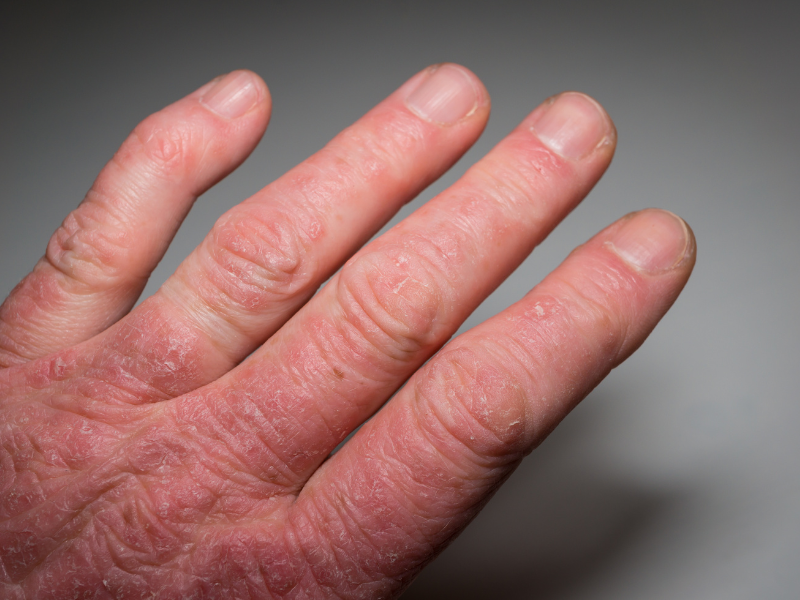Psoriatic Arthritis

Psoriatic arthritis is an arthritis that is associated with psoriasis. It is a persistent skin ailment with no cure. Skin rashes, joint pain and stiffness, and changes in your fingernails and toes are the most prevalent symptoms. However, your doctor can help you identify therapies to alleviate your symptoms.
What is psoriatic arthritis?
Psoriatic arthritis is an autoimmune disorder where the immune system mistakenly attacks healthy joints and skin. It exhibits characteristics akin to rheumatoid arthritis (RA), particularly in symptoms and joint inflammation. Typically, it manifests in individuals with psoriasis.
However, it typically impacts fewer joints than RA and does not produce the typical RA antibodies.
Types of Psoriatic Arthritis
Psoriatic arthritis manifests in five distinctive forms. Each with distinct characteristics:
1. Symmetric Psoriatic Arthritis:
· Affects the same joints on both sides of the body.
· Resembles rheumatoid arthritis in distribution and symptoms.
2. Asymmetric Psoriatic Arthritis:
· Involves different joints on each side of the body.
· Typically milder and may affect fingers and toes.
3. Distal Psoriatic Arthritis:
· Primarily affects the joints at the ends of the fingers and toes.
· May involve nail changes.
4. Spondylitis:
· Inflammation of the spine and sacroiliac joints.
· Causes stiffness and discomfort in the neck, lower back, and pelvic region.
What are the symptoms of psoriatic arthritis?
Psoriatic arthritis and psoriasis are both chronic disorders that deteriorate with time. However, there may be times when your symptoms improve or disappear momentarily.
Psoriatic arthritis can damage one or both sides of your body’s joints. Psoriatic arthritis symptoms are frequently similar to those of rheumatoid arthritis. Both disorders induce swollen, painful, and warm-to-the-touch joints.
Psoriatic arthritis, on the other hand, is more likely to cause:
· Foot pain– It can also cause pain where ligaments and tendons connect to your bones. This is very particularly at the sole of your foot or the back of your heel.
· Swollen toes and fingers– Psoriatic arthritis can cause sausage-like, painful swelling of your fingers and toes.
· Lower back pain- Some people may develop spondylitis. Spondylitis causes inflammation of the joints between the vertebrae of your spine and the joints between your spine and your pelvis (sacroiliitis).
· Nail changes– Nails can form tiny dents (pits). It may separate from the nail beds, or it may crumble.
· Inflammation in the eye- Uveitis can cause redness, pain, and blurred vision. Uveitis can cause visual loss if left untreated.
How to treat psoriatic arthritis?
How psoriatic arthritis is addressed depends on various factors, including:
· Age
· Symptoms
· overall health
· the extent of the condition
Treatment aims to manage both joint inflammation and skin manifestations. Medications commonly used include:
- Corticosteroids: Administered to address inflammation.
- Nonsteroidal anti-inflammatory drugs (NSAIDs): Employed to alleviate symptoms.
- Immunosuppressive medicines: Used to reduce inflammation when NSAIDs prove ineffective.
- Vitamins and minerals: Prescribed to slow down bone deformation.
- Biologic medicines: Designed to alleviate inflammation.
Additional components of treatment may involve:
- Exercise: Incorporating physical activity into the routine.
- Occupational therapy: Assisting in daily activities.
- Heat and cold therapy: Applying temperature-based interventions for symptom relief.
- Physical therapy: Focusing on enhancing muscle and joint function.
- Splints: Providing support for affected joints.
- Psoriasis skin rash management: Addressing skin-related symptoms.
- Surgery: Reserved for cases requiring joint repair or replacement. It is typically not necessary until years post-diagnosis.
- Ultraviolet light treatment (UVB or PUVA): Utilized as a therapeutic measure.



